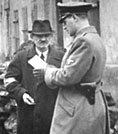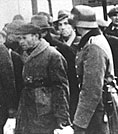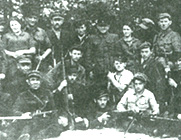|
Despite
the strength of the armed and powerful Nazis,
there were Jews
who resisted and tried to prevent their fate. However, there
were also many obstacles to resistance.
Obstacles
to resistance.
Many
Jews refused to believe the stories they had heard about the
mass killings of men, women and children in extermination
camps. They clung onto the hope of survival and therefore
did little to resist their fate. They simply could not understand
that it was possible to exterminate hundreds of thousands
of Jews.
 The
strength and might of the German army terrified many people.
As it only took a matter of weeks for the German army to overcome
Poland and France, it seemed as if the Jews would have little
chance of resisting such an overwhelming force. The Nazis
also used a retaliation tactic that held groups of people
responsible for individual acts of resistance. Families and
even whole communities would often be killed to punish those
who had tried to resist. The Nazis had planned the deportations
meticulously and the speed, secrecy and deception of these
lulled the Jews into a false sense of security. Many thought
they were being deported to labour camps to be resettled in
the East. The
strength and might of the German army terrified many people.
As it only took a matter of weeks for the German army to overcome
Poland and France, it seemed as if the Jews would have little
chance of resisting such an overwhelming force. The Nazis
also used a retaliation tactic that held groups of people
responsible for individual acts of resistance. Families and
even whole communities would often be killed to punish those
who had tried to resist. The Nazis had planned the deportations
meticulously and the speed, secrecy and deception of these
lulled the Jews into a false sense of security. Many thought
they were being deported to labour camps to be resettled in
the East.
Physical
weakness was also an obstacle to resistance in the ghettos
and camps. Jews in the ghettos were systematically starved
and were susceptible to disease before they were rounded up
for deportation, leaving many of them in a weakened state.
Jews
would also find themselves isolated from their neighbours,
as many Jews in Eastern Europe were unable to blend easily
into a non-Jewish community due to differences in accent and
language, religious customs and physical appearance. For example,
male Jews, being circumcised, were easily identifiable. In
many cases, non-Jewish Partisans
and underground
fighters refused to supply Jews with arms, which also led
to problems in resisting the Nazis.
Examples
of resistance.
The Jewish
youth groups were more receptive to using arms to fight the
Nazis, as they did not have the same kind of family ties as
older people. Perhaps the most well known act of armed resistance
was in the Warsaw ghetto. Fighting only broke out once it
was clear that Nazis meant to murder Jews in 1941.
The several
thousand Jews who were left after mass deportations of 1942
and 1943 resisted and the rebellion lasted for four weeks
until the Nazis razed the ghetto and burned it down. There
were also armed revolts in death camps including Auschwitz,
Treblinka and Sobibor.
 Resistance
took many forms and other examples besides armed resistance
included moral, spiritual, economic, cultural and political
resistance. In the ghettos, there were many examples of resistance.
Underground movements established soup kitchens to help Jews
survive the terrible conditions, and children were often involved
with dangerous smuggling operations to supplement the meagre
food rations. Some kept diaries and historical archives in
order to prevent the Nazis from hiding all evidence of their
crimes. Despite the dehumanising
and degrading conditions enforced upon them, there were Jews
who resisted by maintaining their dignity and pride. For example
the Nazis forced the Jews to wear the Yellow Star as a badge
of shame, to mark out and humiliate them but there were those
who wore it proudly as a badge of honour. Resistance
took many forms and other examples besides armed resistance
included moral, spiritual, economic, cultural and political
resistance. In the ghettos, there were many examples of resistance.
Underground movements established soup kitchens to help Jews
survive the terrible conditions, and children were often involved
with dangerous smuggling operations to supplement the meagre
food rations. Some kept diaries and historical archives in
order to prevent the Nazis from hiding all evidence of their
crimes. Despite the dehumanising
and degrading conditions enforced upon them, there were Jews
who resisted by maintaining their dignity and pride. For example
the Nazis forced the Jews to wear the Yellow Star as a badge
of shame, to mark out and humiliate them but there were those
who wore it proudly as a badge of honour.
 Cultural
activities thrived in the ghettos, sometimes in secret and
sometimes permitted by the Nazis. There are accounts of musical,
operatic and theatrical performances and many examples of
poetry and artwork from the ghettos survived as evidence to
the terrible conditions.Although
education was forbidden in the ghetto, children attended school
in secret and adults continued to study religious texts. Giving
birth in the ghettos was strictly prohibited, but despite
this and at great risk to their own lives, adults married,
gave birth and conducted ritual circumcisions on male children.
These acts of resistance were of a spiritual kind, and were
meant to preserve the Jewish faith. Cultural
activities thrived in the ghettos, sometimes in secret and
sometimes permitted by the Nazis. There are accounts of musical,
operatic and theatrical performances and many examples of
poetry and artwork from the ghettos survived as evidence to
the terrible conditions.Although
education was forbidden in the ghetto, children attended school
in secret and adults continued to study religious texts. Giving
birth in the ghettos was strictly prohibited, but despite
this and at great risk to their own lives, adults married,
gave birth and conducted ritual circumcisions on male children.
These acts of resistance were of a spiritual kind, and were
meant to preserve the Jewish faith.
In order
to save lives, families hid from their persecutors and sometimes
escapes occurred. Some sacrificed their own lives for other
individuals, whilst others chose to kill themselves, realising
that they would inevitably be killed by the Nazis.
 |
| The
Bielski partisans |
Keeping
themselves well informed of current events was also an act
of resistance, and access to forbidden news and radios helped
to keep morale high. Jews joined partisan groups all over
Europe, blowing up railways, attacking troops and carrying
out sabotage.
For example, survivor Jack Kagan
escaped the Nazis and joins a group of Russian, Jewish partisans.
Most of the partisans survived the Holocaust by hiding in
the dense forest near Novogrodek.
In this
section, Trude Levi talks
of her act of sabotage in a munitions factory. There are also
descriptions of the resistance of the Sonderkommando
in Auschwitz and also acts of non-Jewish resistance. The Sonderkommando
received explosives from a group of four Jewish women. They
succeeded in blowing up Crematorium IV and 300 Sonderkommando
attacked their SS
guards with stones and work tools.
There
were also couriers who smuggled arms into the ghettos, ran
illegal printing presses and arranged escapes. They mainly
travelled in occupied Poland and the Soviet Union using false
names and papers. They carried illegal documents, newspapers
and money with them. People also stole weapons, produced faulty
munitions and set fire to factories in order to sabotage the
German war effort. There were a few groups of non-Jews who
openly opposed the Nazi genocide
against the Jews. An example of this is The White Rose Group
in Germany. A student at Munich University founded this group
in 1942. They disseminated anti-Nazi leaflets and advocated
sabotage in munitions factories. They were betrayed by a caretaker
at the University and executed by Nazis in 1943. Non-Jewish
partisan groups also fought against the Nazis and sabotaged
their actions. In Israel today, the Yad Vashem, the Holocaust
Martyrs and Heroes' Remembrance Authority, honours non-Jewish
people who helped the Jews. They are given the title 'Righteous
Gentiles'.
|